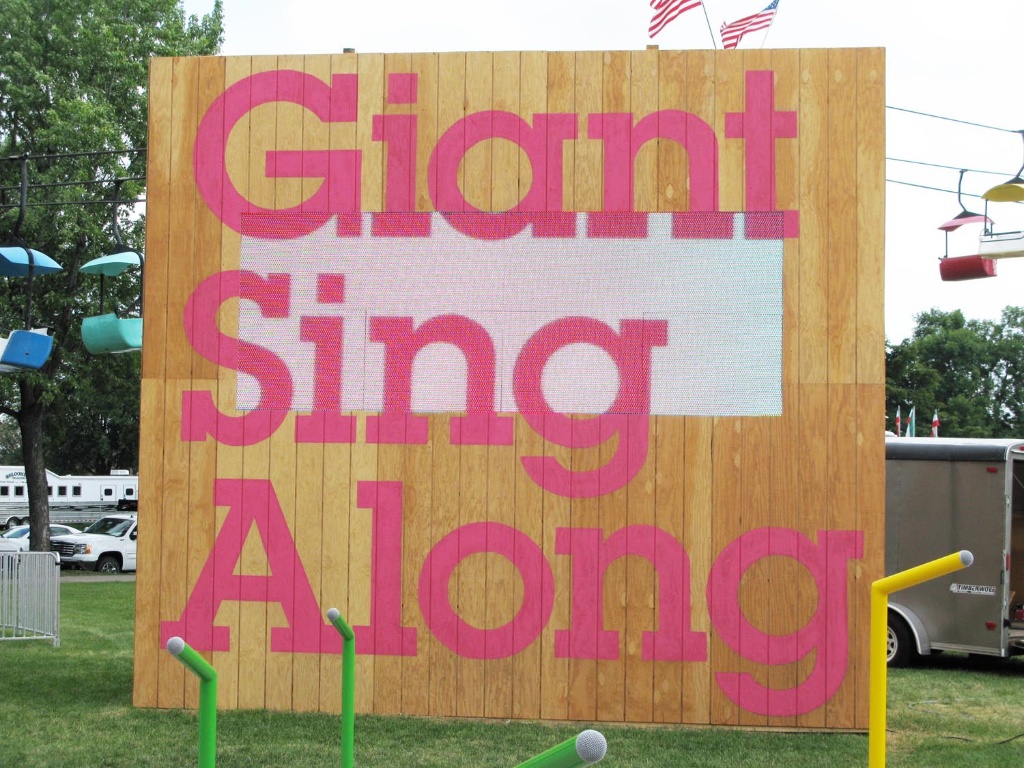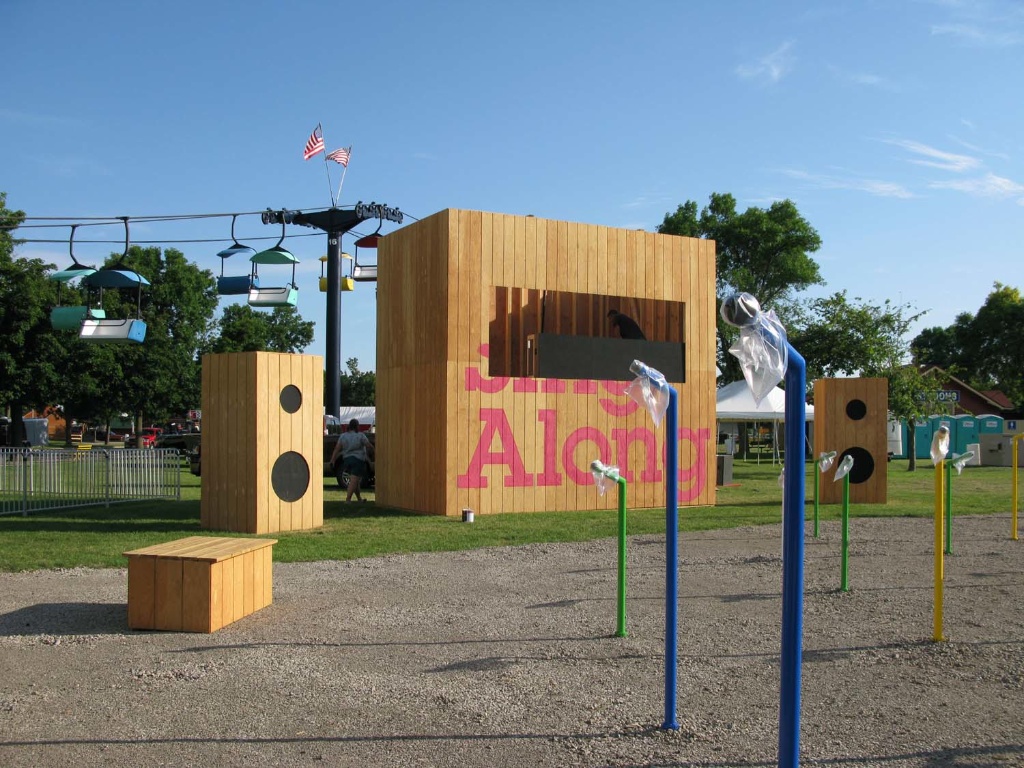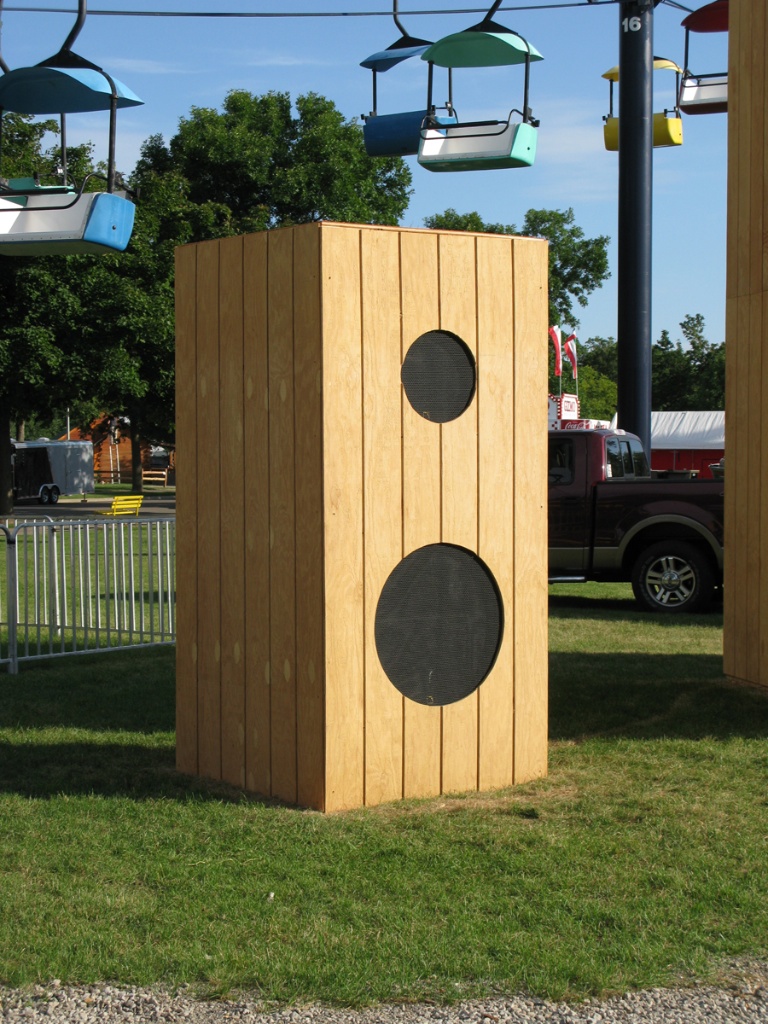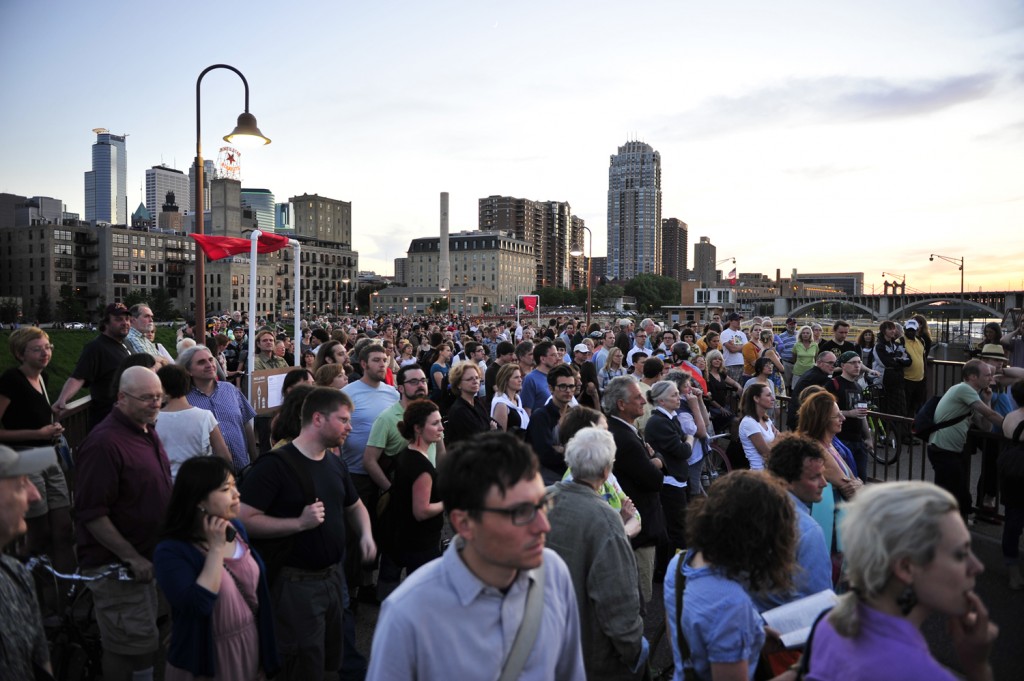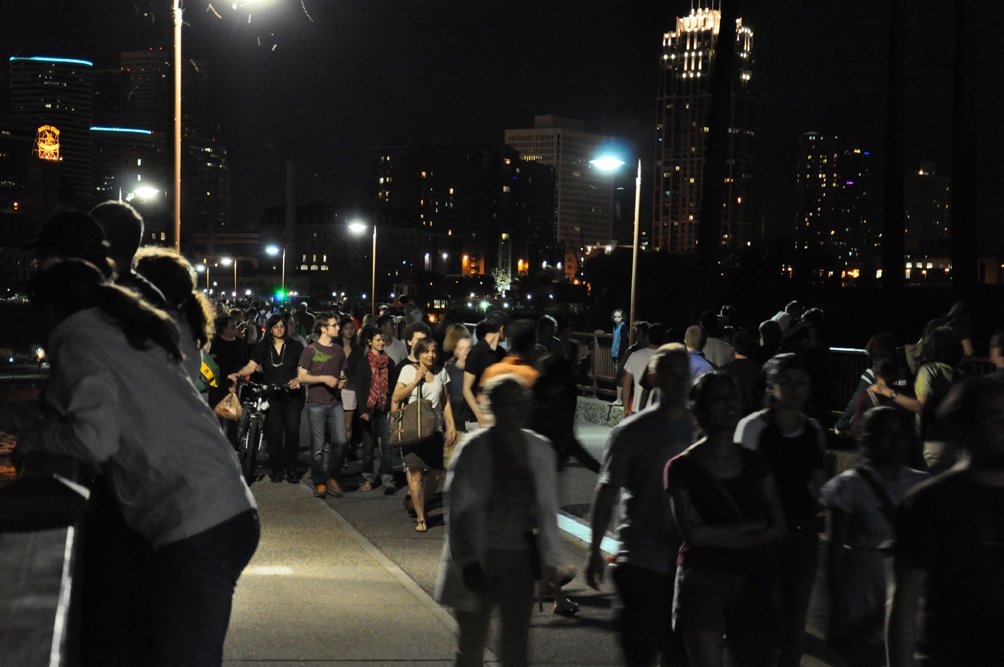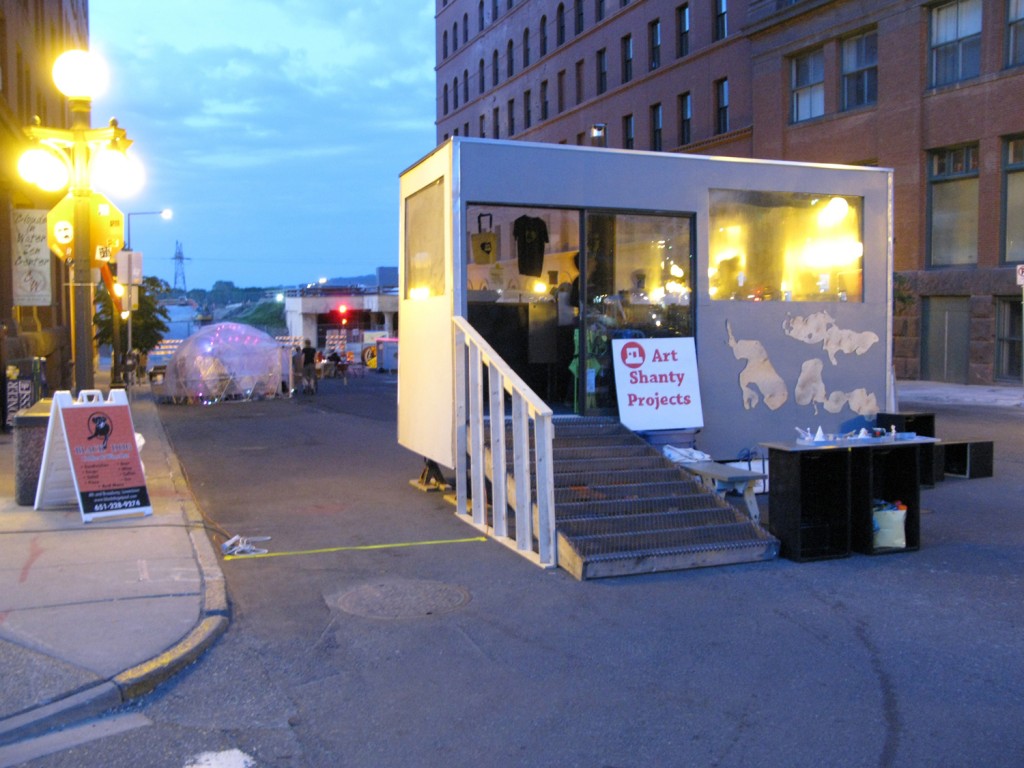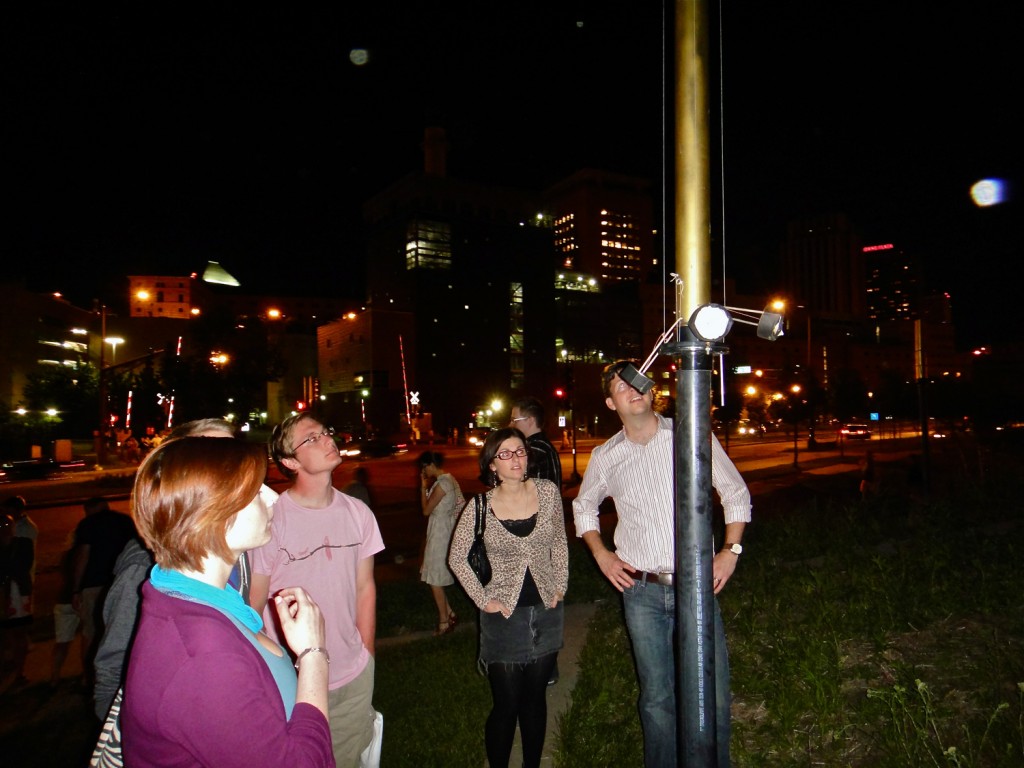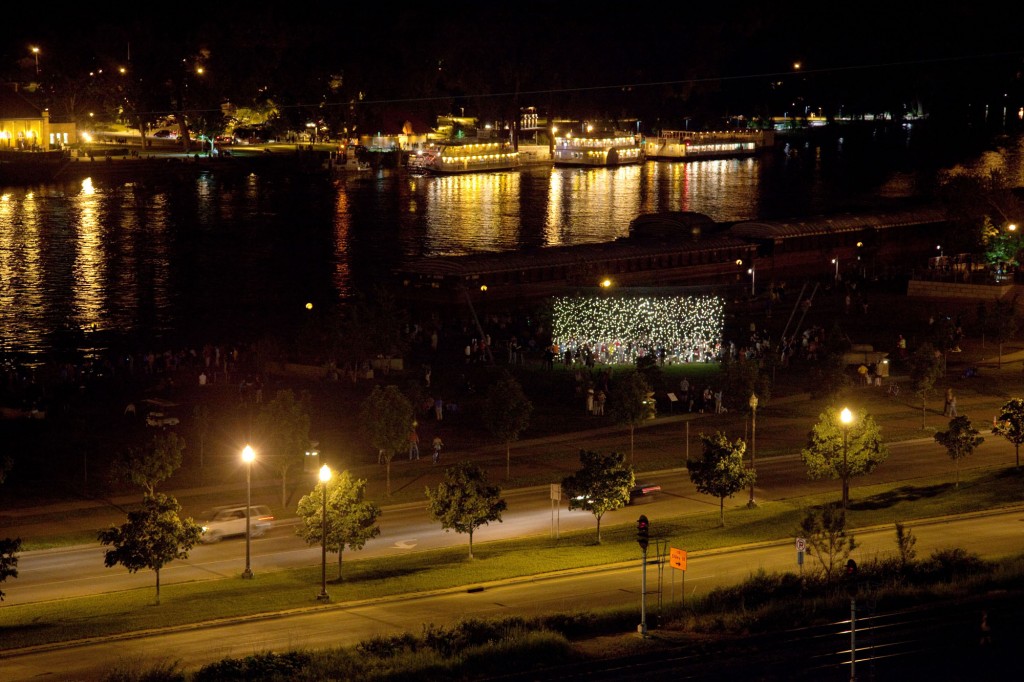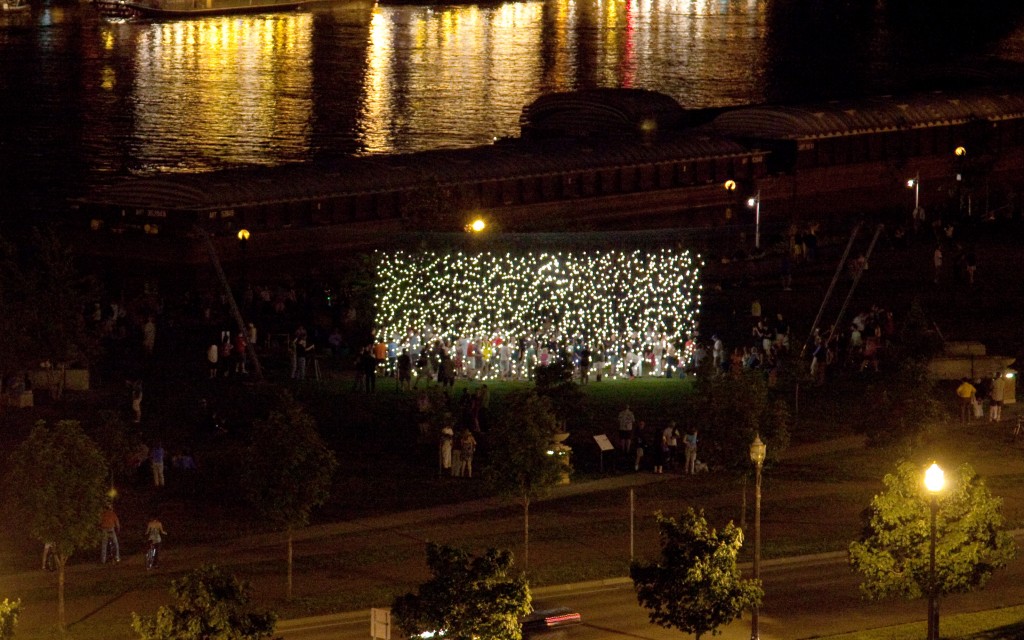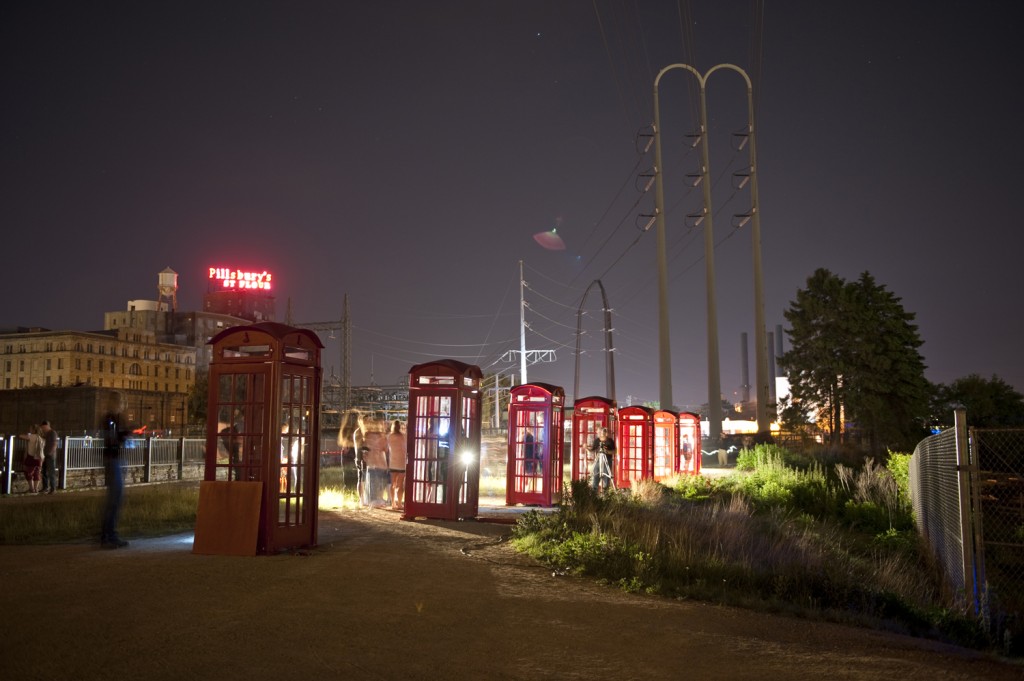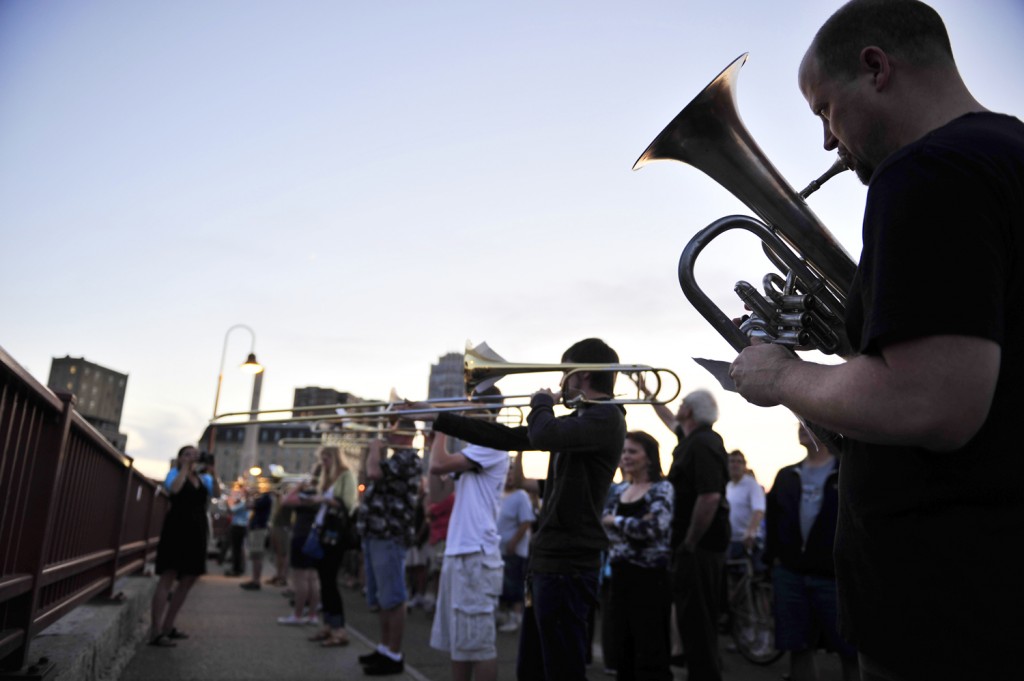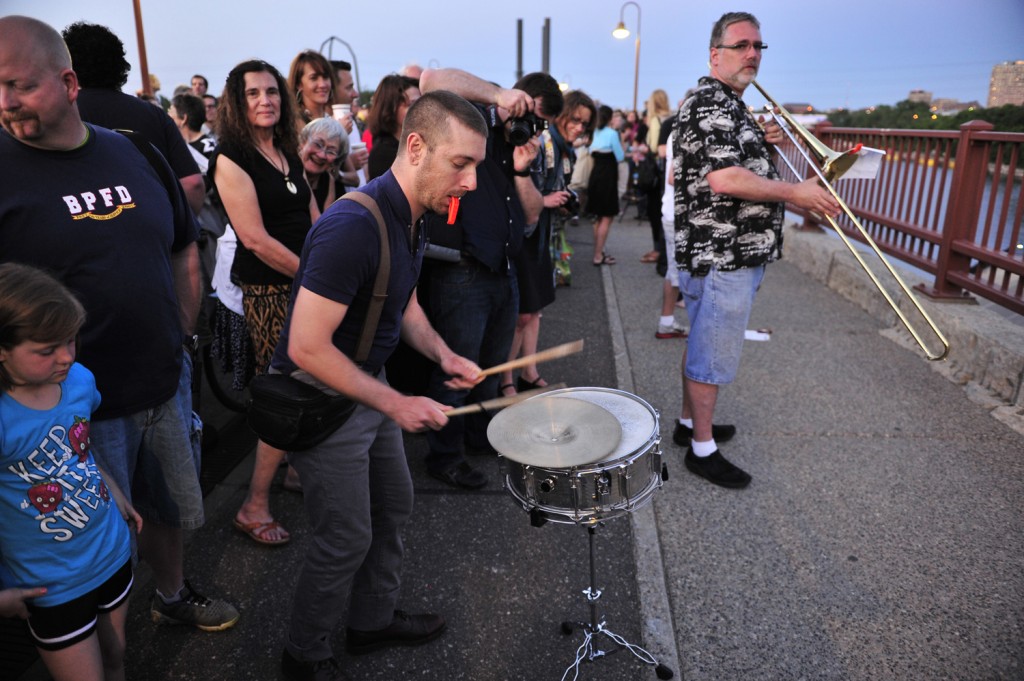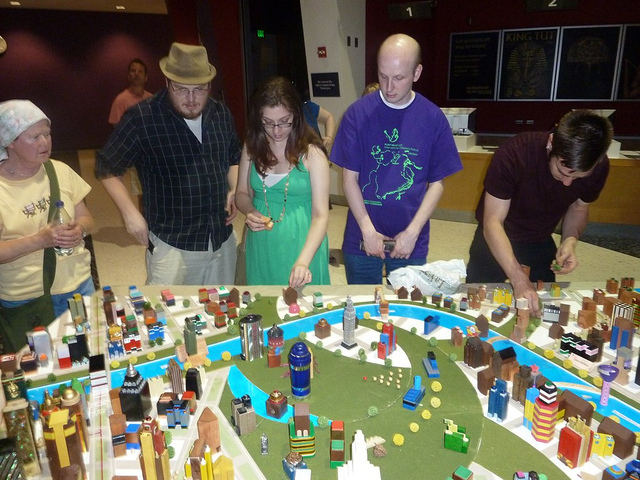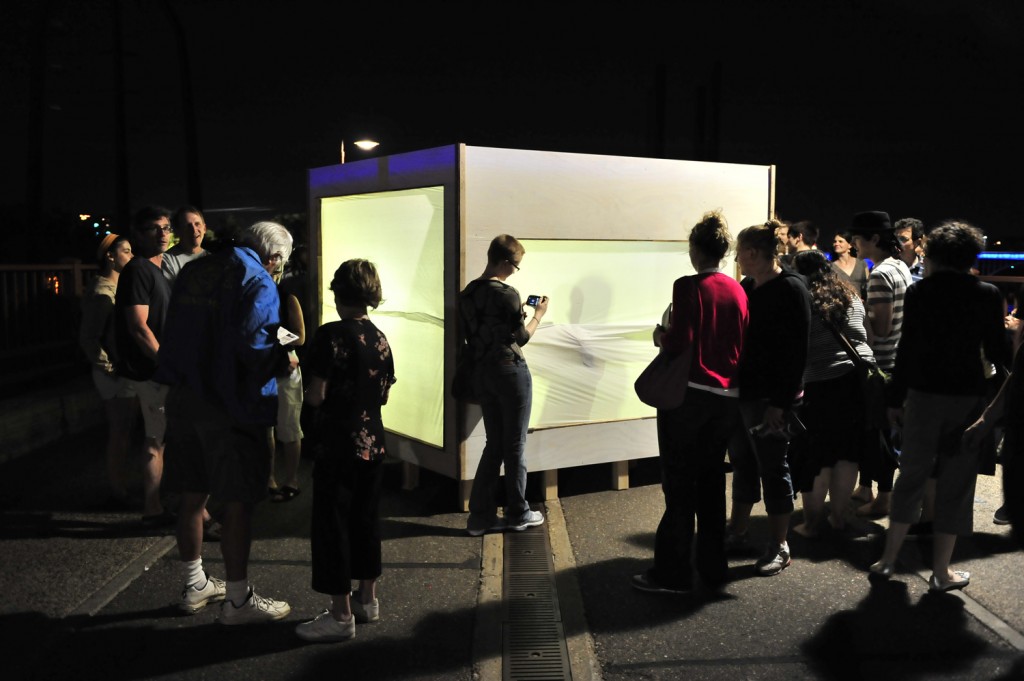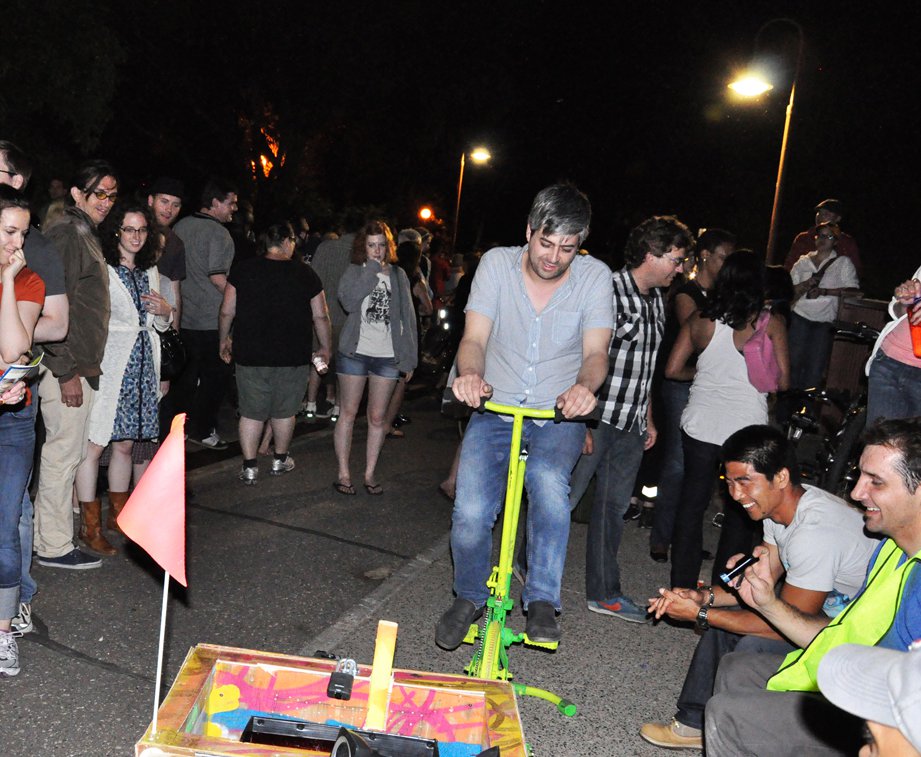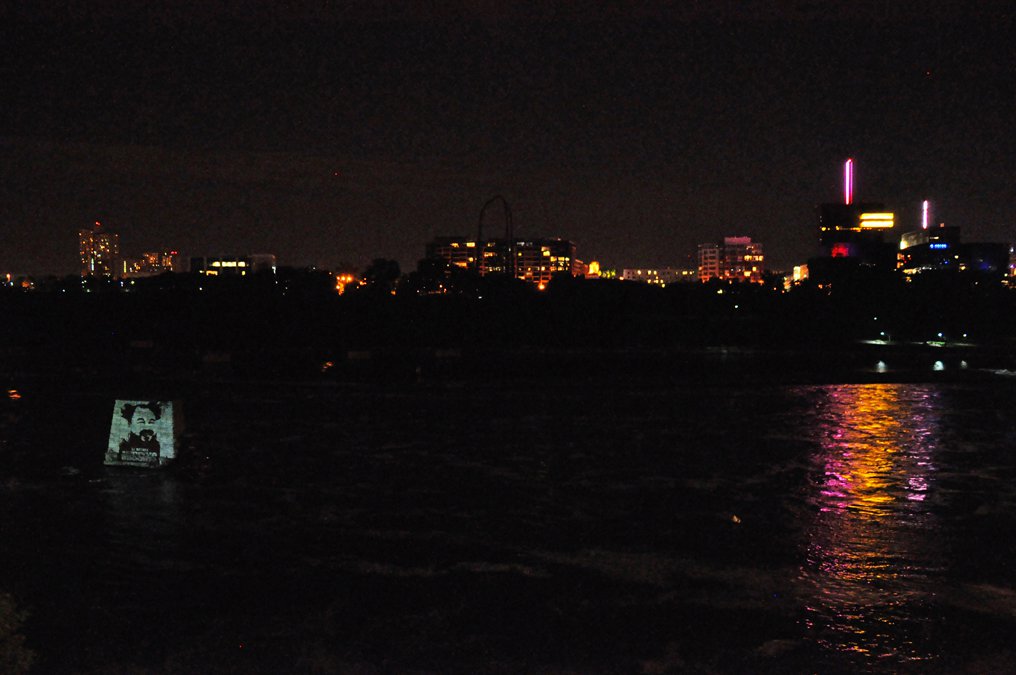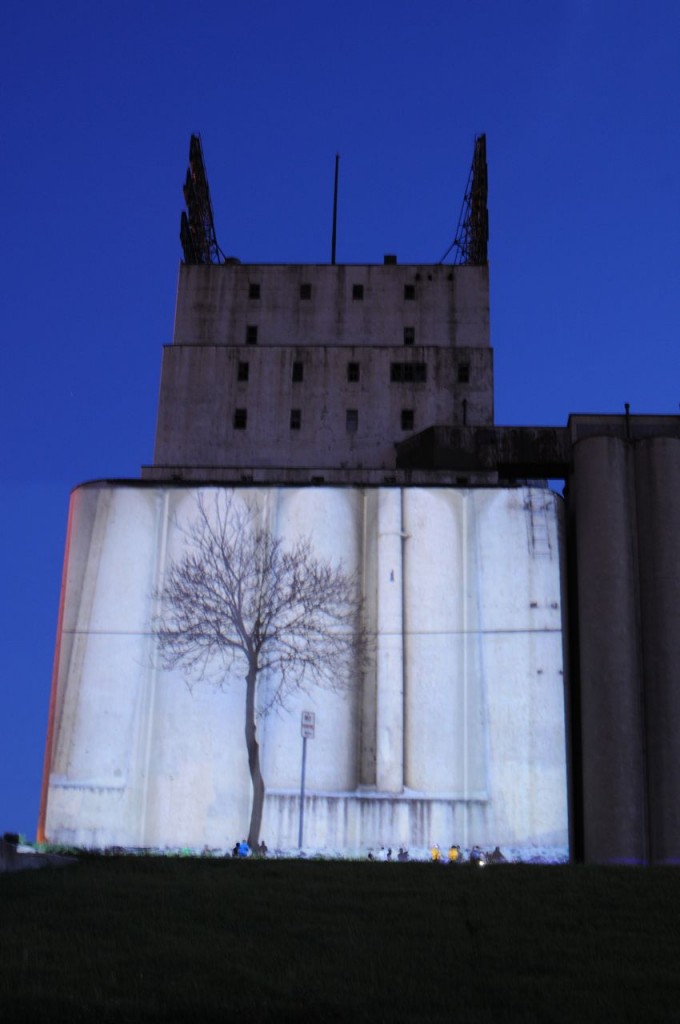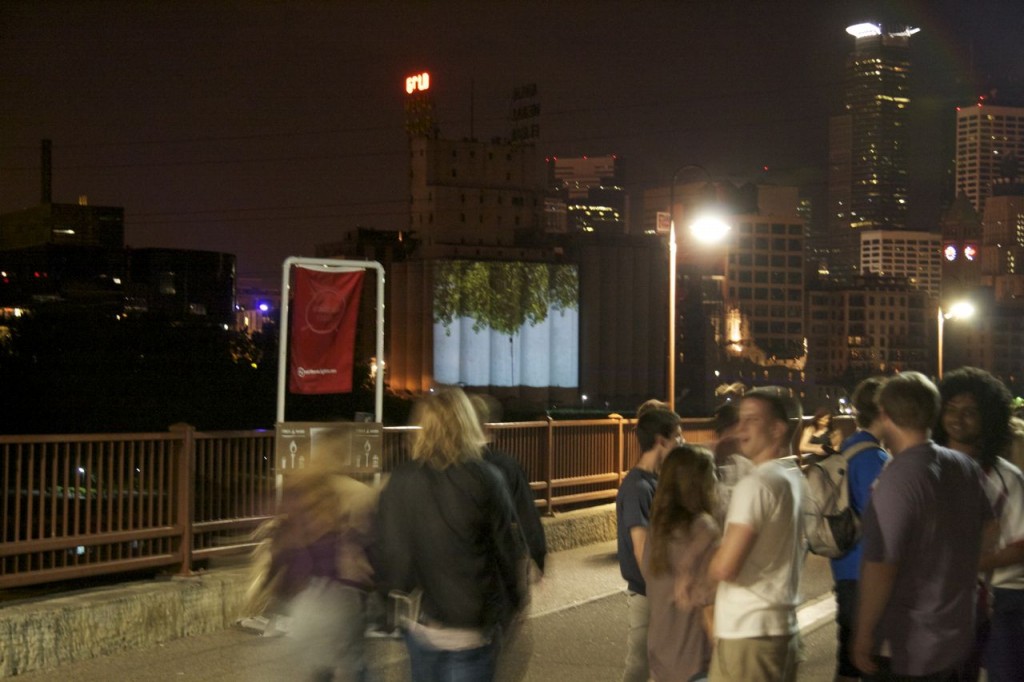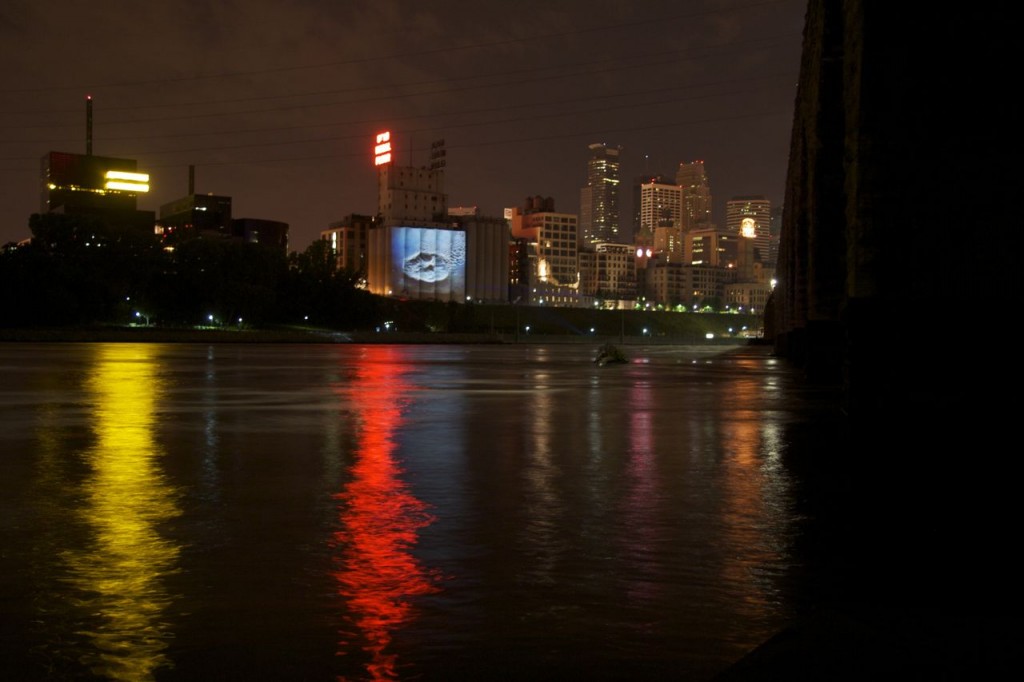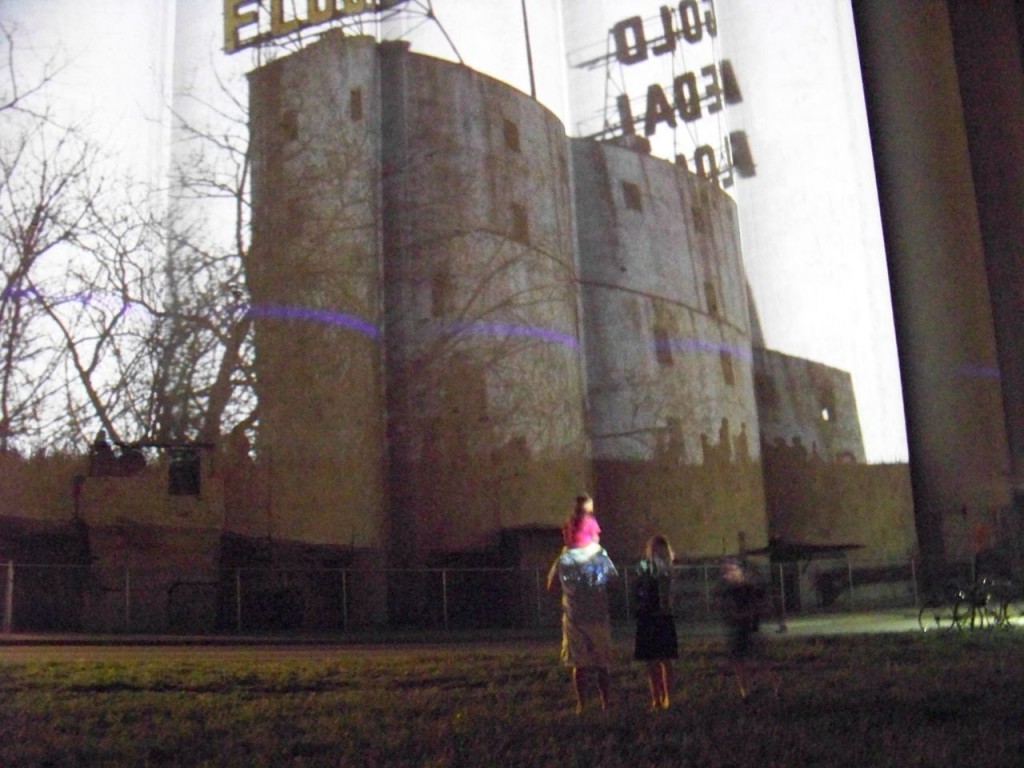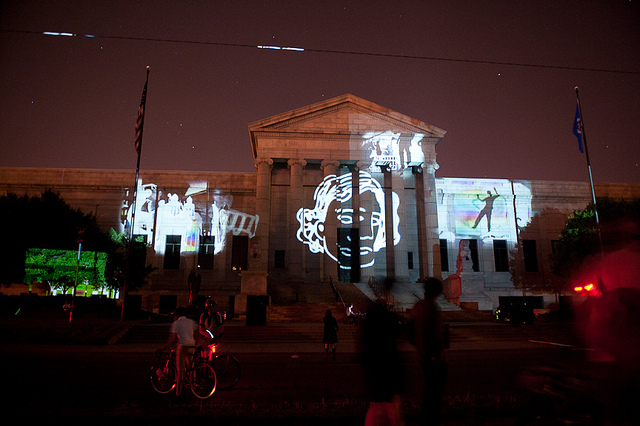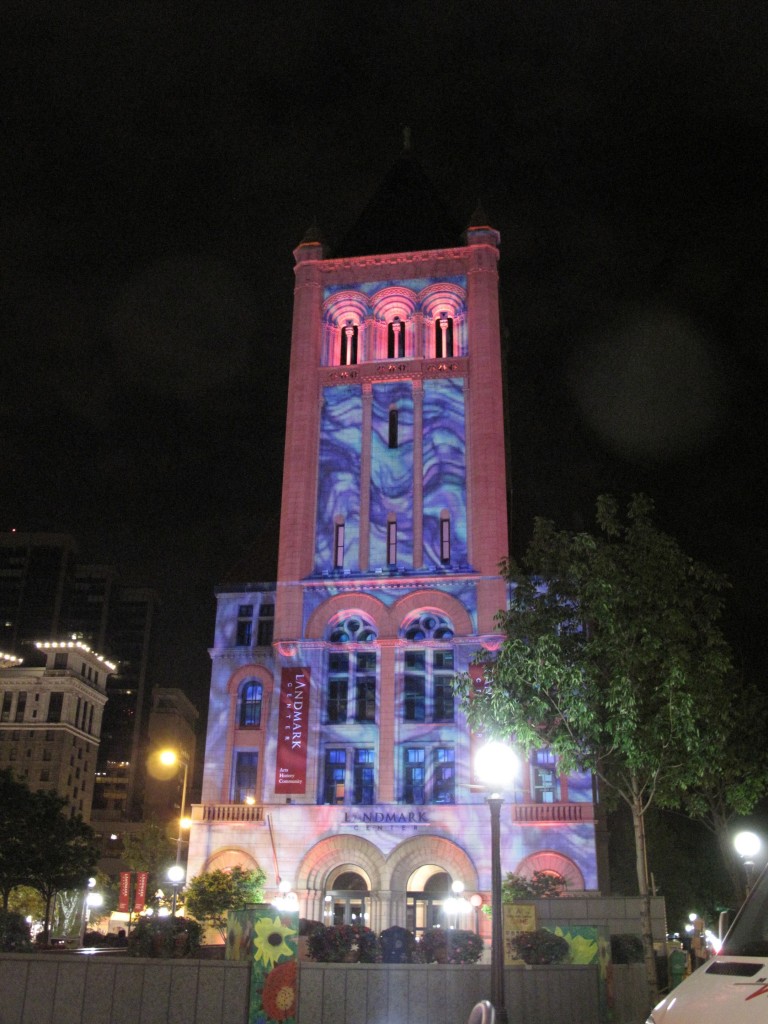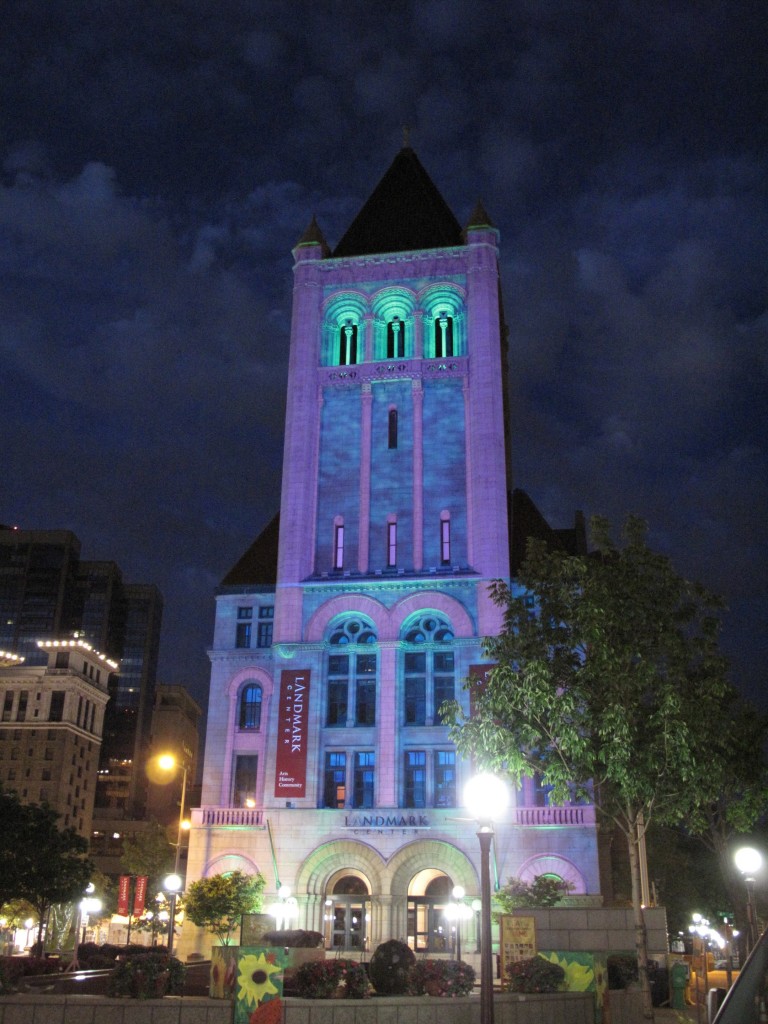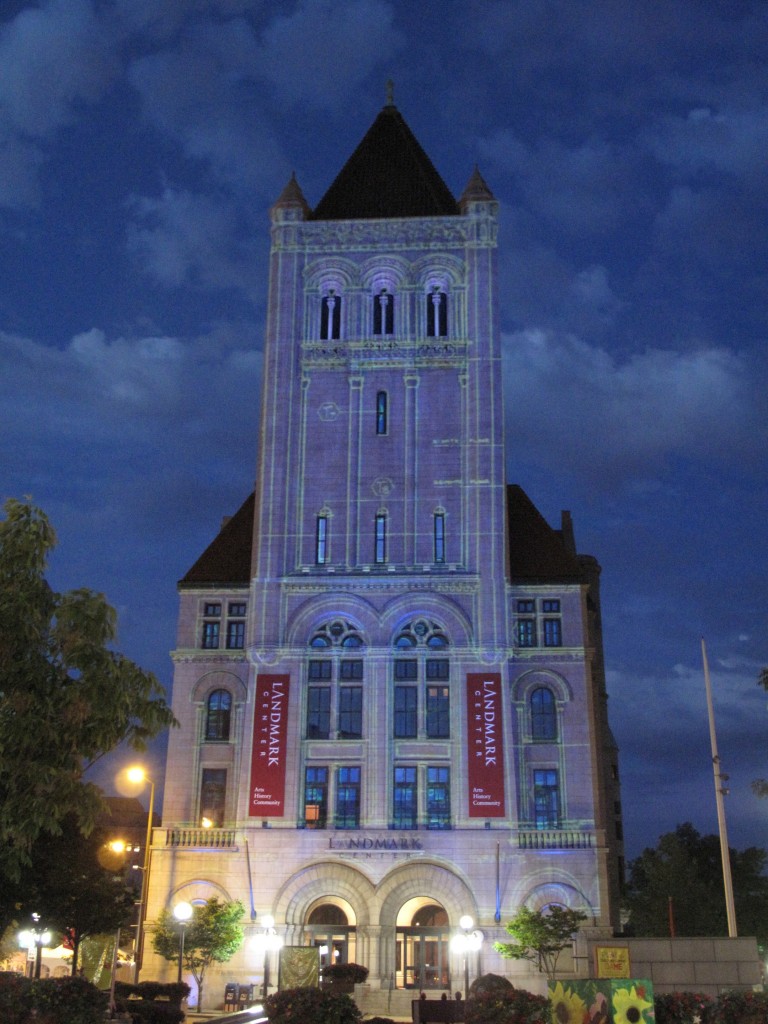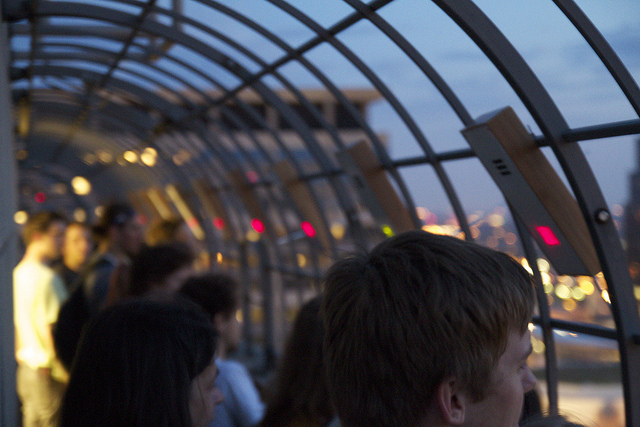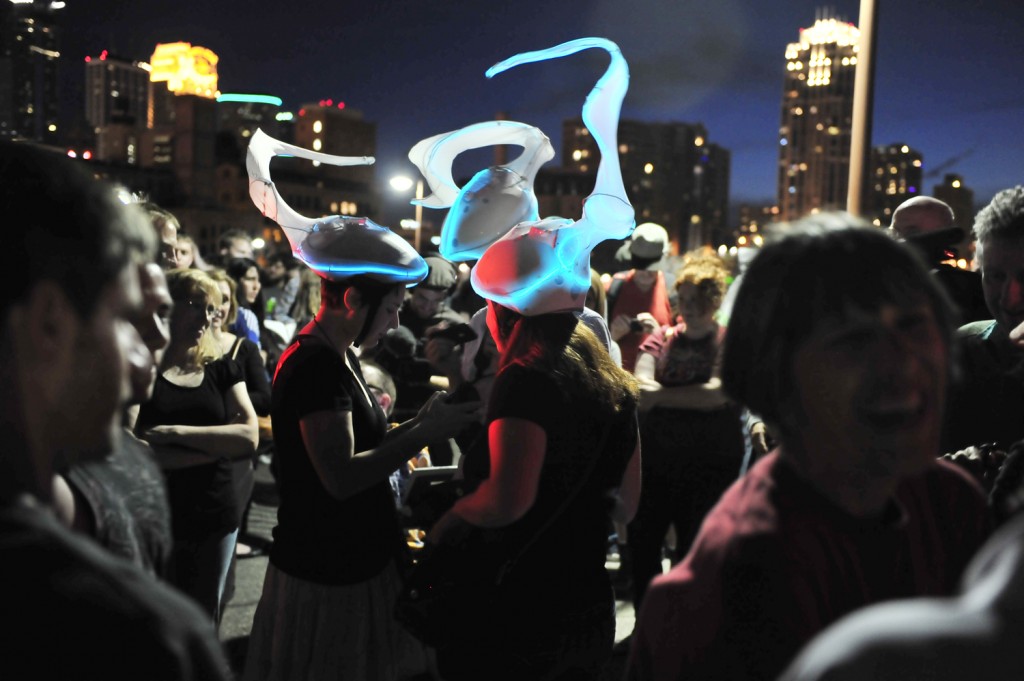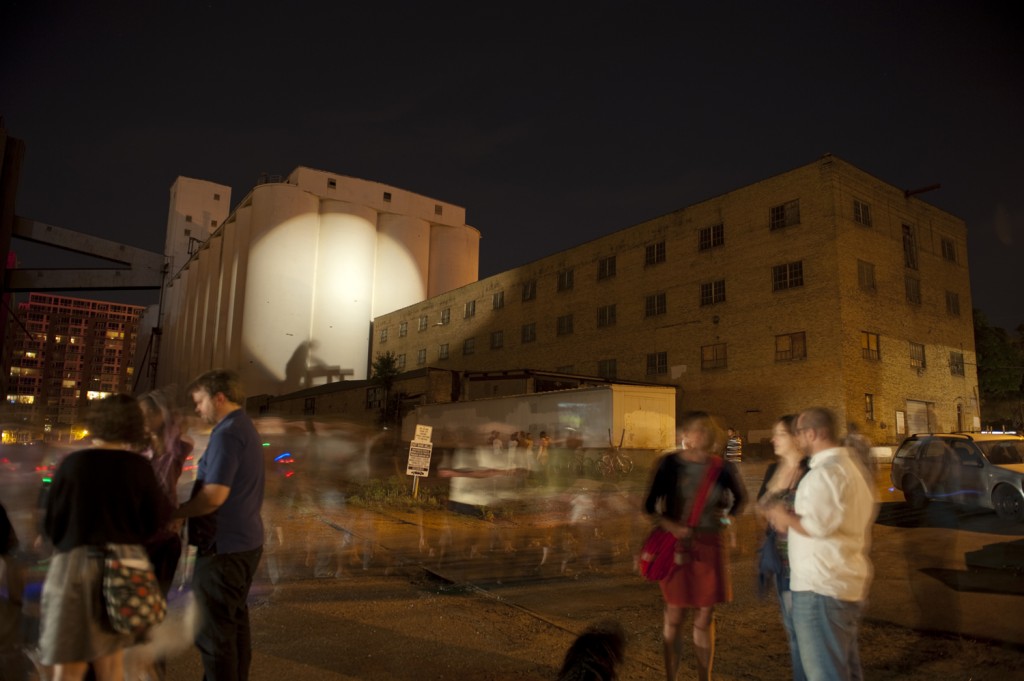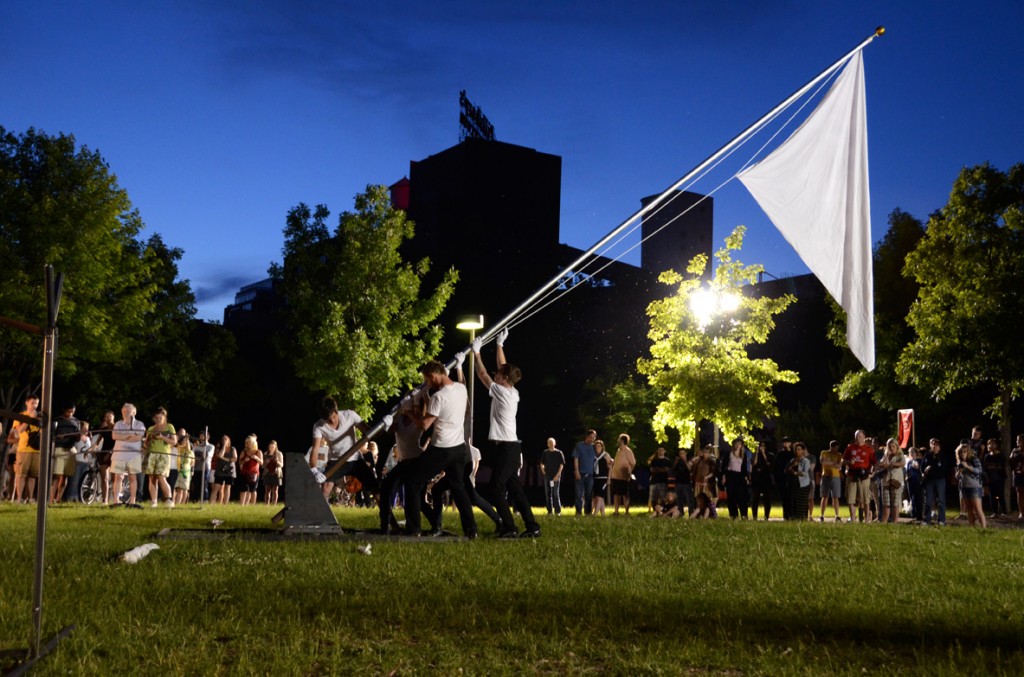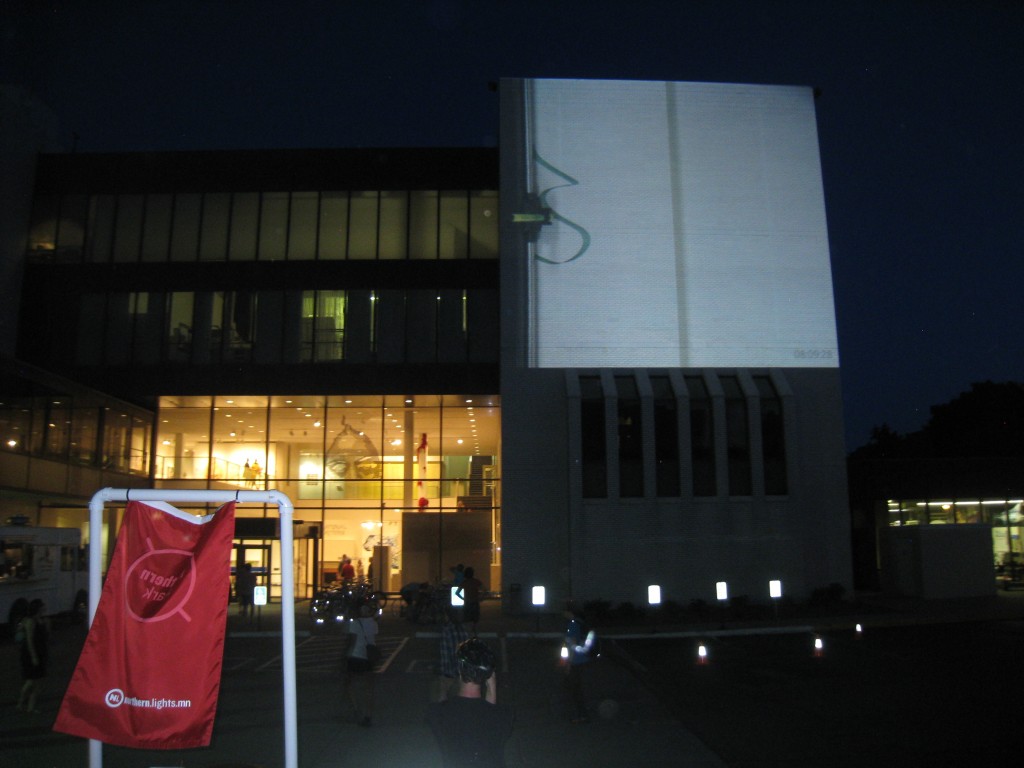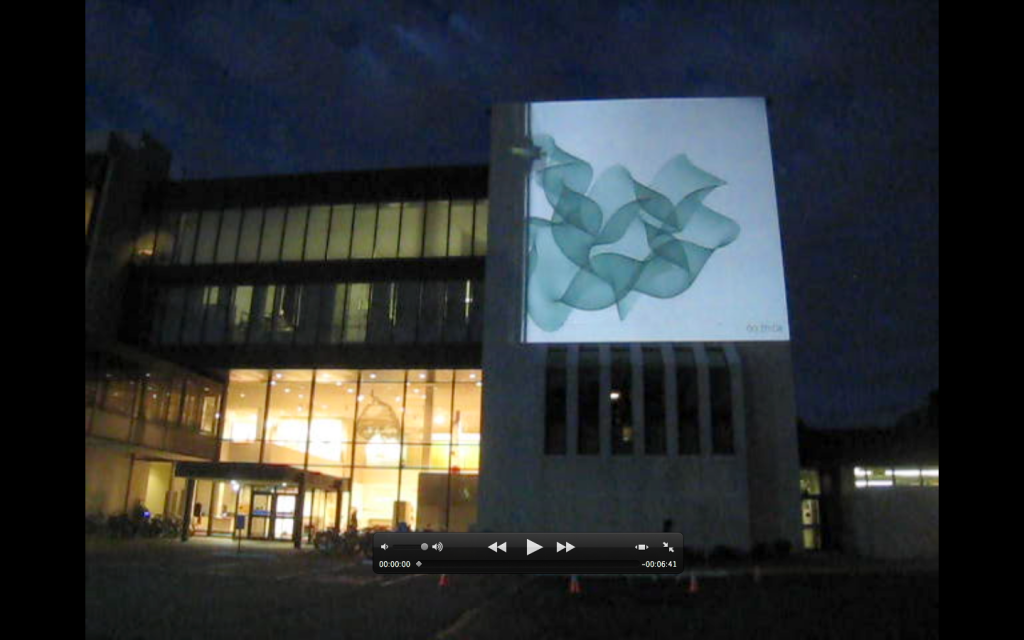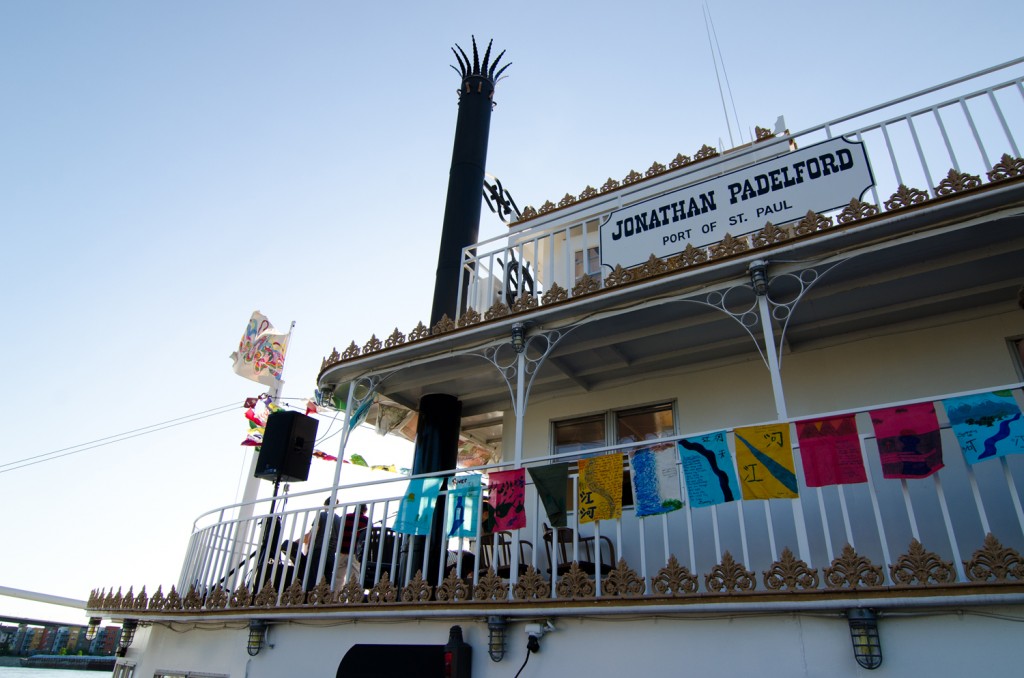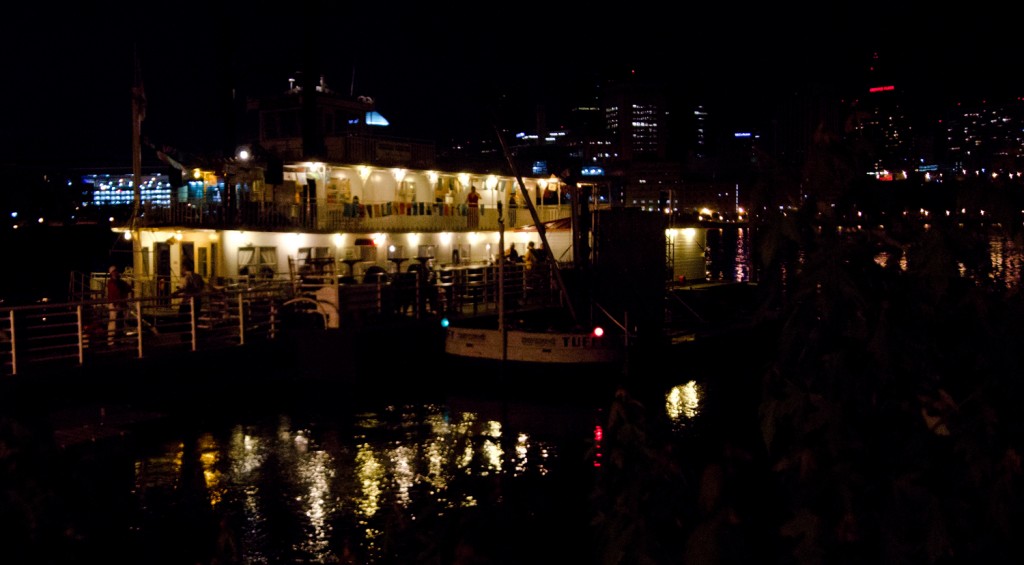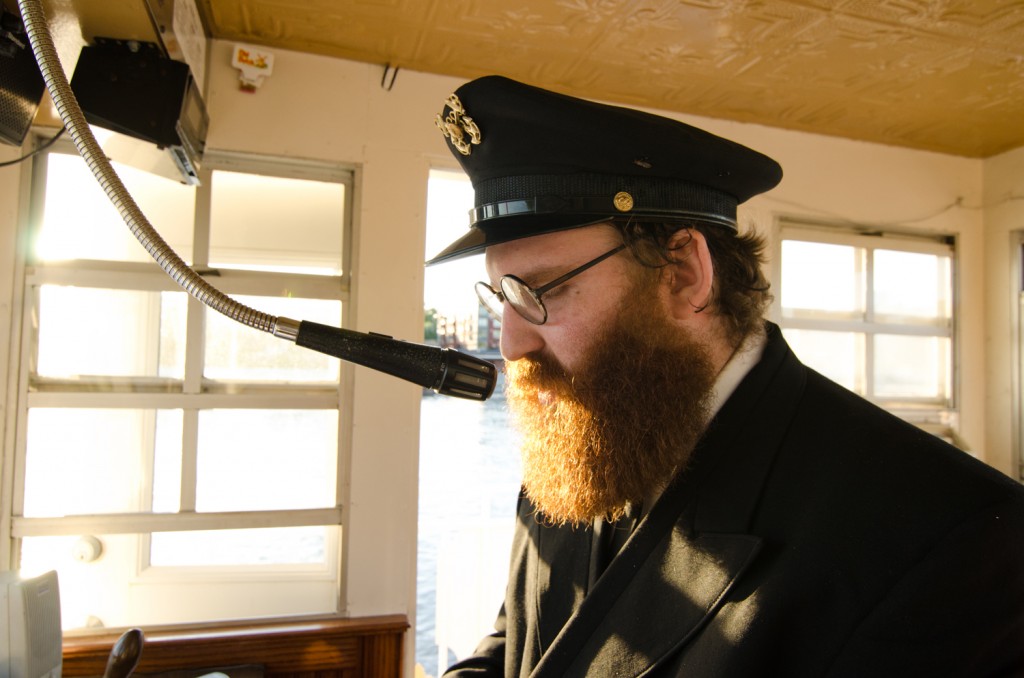Waste Not
We are still getting in final documentation of Northern Spark. There is a great photo essay of the event here. Above is video documentation of Christopher Baker’s Waste Not. The projection visualizes in real time time a data dump of the garbage that accumulates every day in Minneapolis. And while not yet part of the public interface, the project is programmable to isolate and visualize various aspects of the waste stream from diapers to plastic.
Baker is also currently showing Murmur Study, at Pace Gallery in New York, a work first commissioned for the Art(ists) on the Verge program.
Bruce Charlesworth: ISEA.1
Arriving late Thursday night in Istanbul after a full day of teaching and a drive from Milwaukee to catch my connecting flight to Frankfort from O’Hare… I am jetlagged. I’m in Istanbul for the ISEA (International Society of Electronic Artists) Festival and Conference. Given that I am two days late for the festival, my account will be limited and personal. I’ve already missed much, and will miss more. Simultaneous events are scattered all over Istanbul, and navigation is tricky.
I made it to the conference in the sub-sub-basement of a financial complex, and sat through several sessions of artists and curators presenting papers. Topics included “The Body and Digital Space,” “Philosophy and Ethics of Bioart,” “Locative Sound,” “Robotics, Interactivity and Public Space.” For more information, click here and select Paper Sessions:
That evening, I groggily traveled by funicular and tram to the Sultanamet area of the Old City and went to a Turkish bathhouse to see Southern Ocean Studies by Tom Corby, Gavin Baily and Jonathan Mackenzie.
Projected on the domed entrance hall ceiling of the 427-year-old Çemberlitas Hamam, the artwork depicts the Southern Ocean circulating Antarctica. According to the artists, the project software runs in real-time generating the ocean currents on the fly, to which are mapped various other ecological data sets.
The back-and-white visualization of wind and tide evoked phenomena both small and large: lines of crawling ants and storm-tracking satellite maps. I like the idea of superimposing vortex-like imagery on a dome, and data from a cold place onto one that features heat. As with many new media works with a sociopolitical or scientific agenda, this one was more interesting to me in terms of its real-time data mapping content and symbolism than as a formal artwork. Both the intellectual and aesthetic impact of the piece might have been served by a larger, more encompassing projection in one of the huge domed hot rooms where bathers sweat on their backs while looking upward. For technical or cultural reasons, these options may not have been feasible in a traditional hamam.
I decided to have a Turkish bath.
Bruce Charlesworth is an artist, writer and filmmaker. He one of the pioneers of postmodern staged photography and among the first artists to use video and audio to power aspects of physically immersive “narrative environments.” He teaches in the Department of Film/Video/New Genres at the University of Wisconsin Peck School of the Arts in Milwaukee. He previously reported on Ars Electronica in 2009 for Public Address.
Giant Sing Along: Don’t stop believing
3 more days!
Prairie Fire Lady Choir at Giant Sing Along
Hold hands with a stranger
Amanda Lovelee’s Call and Answer Project was an epic success at Northern Spark.

Call and Answer at Minnesota Center for Book Arts, Northern Spark, June 4, 2011. Photo courtesy the artist.
According to Amanda,
“We reached all our goals and went far beyond. In one evening we served over 400 pieces of pie in two hours, printed 2000 books, had close to 50 amazing volunteers who did everything from bake pie, photograph, cut pie, make coffee, run a letter press, greet people at the door, read their poetry, play in the band, and call a square dance! I think about 1,500 people came through the doors of the Minnesota Center for Book Arts and at least 500 strangers held hands!!!!”
Amanda is going for it again.
The Call and Answer Project will be coordinating the largest square dance in the Twin Cities as part of the Walker Art Center’s Free First Saturday from 12-3pm on Saturday September 3rd. The day’s events will include a photo booth where if you pose for a photograph holding hands with a stranger you will receive one of the four books from the collector set of handmade letter pressed books that Lovelee designed about life lessons learned through square dancing. Each book was printed by volunteers as part of Northern Spark and folded by another volunteer. There will a space for both kids and anyone who wants to add a drawing to a very long and large accordion book of utopic objects. It will be the premier of Call and Answer, a short documentary about human connection and Minneapolis’s Monday Night Square Dance. The movie will be playing on a loop inside the Walker. Most importantly from 1pm-3pm there will be a live band playing and square dancing! Local caller Ann Carter will be teaching you everything you need to know.
For more information please go to – http://callandanswer.wordpress.com/ or
http://blogs.walkerart.org/openfield2011/event/free-first-saturday-square-dance-withamanda-
lovely/
If I can’t dance . . .
All promo videos for an exhibition should be this entertaining!
Opening August 11, “The Walker presents the latest phase and first US exhibition of Baby Marx, an ongoing project by Mexican artist Pedro Reyes that looks at the potential for mass entertainment to operate as a radical educational tool.”
At the end of the video, above the subtitle Romance, it appears that Che Guevara is hitting on a school teacher/librarian, who is the only woman who appears in the trailer. I wonder if the exhibition will include female theoreticians and activists?
Battle of Everyouth
Battle of Everyouth by Ali Momeni and Jenny Schmid with students from Washburn High School was presented at Northern Spark. It is a projection-based performance staged at multiple sites on and around the Minneapolis Institute of Arts , which is blend of live cinema, participatory theater and live performance. The Battle of Everyouth creates a context for exploration and conversation on the theme of global youth and violence.
A “mixing station” staged in front of the museum produces large-scale panoramic projections onto its facade using live video feeds from numerous dispersed performance contexts. The performance contexts that generate the raw materials of the projection are centered around a miniature urban set on display outside the museum. These performance contexts are run by students from Washburn High who act as the messengers as well as the listeners in this work. They use two types of devices in their interactive rapport with the public, which are both mobile and wireless. The first is an ornate hat, which is designed to capture up-close video footage of faces. The second is an augmented briefcase used to capture writing and drawing with markers. Video feeds from these interaction devices are projected onto architectural components in the miniature set, and simultaneously recorded and manipulated by Momeni and Schmid as they project at large scale onto the museum.
Supported by
MIA Inside/Out: Battle of Everyouth is made possible by a Joyce Award and a grant from the Friends of the Institute with additional support from Best Buy Children’s Foundation. Presentation of The Battle of Everyouth at Northern Spark is also made possible in part by a grant provided by the Minnesota State Arts Board, through an appropriation by the Minnesota State Legislature from the Minnesota arts and cultural heritage fund with money from the vote of the people of Minnesota on November 4, 2008.
Machine Project Summer Jubilee
LA-based Machine Project is coming to the Walker Open Field. You don’t need to choose between Tragedy on the Sea Nymph: An Operetta in Three Acts Starring an All-Dog Cast, Car Theft for Kids, the Apple II Beeptacular Spectacular or Mowing the Field – with bells on. It’s all happening during the Machine Project Summer Jubiliee July 19-29. Check out the line up and don’t miss at least 7 of the projects by this remarkable group during this limited engagement of limitless engagement.
http://vimeo.com/25989349
Karolina Sobecka, Forth
http://vimeo.com/25636588
I have to admit I love most of Karolina Sobecka’s work. This new responsive, generative lobby video with immersive sound, Forth, seems amazing.
I’m sure there were functional and likely budget reasons, but it’s a little disappointing that it’s such a SCREEN, especially in contrast to a lot of her other work.
Sobecka was part of the MAW residency program in 2010, and her Wildlife was a big hit at the inaugural 01SJ Biennial/ISEA Symposium.
http://www.youtube.com/watch?v=CufzjUfINgA
Karolina Sobecka, Forth
http://vimeo.com/25636588
I have to admit I love most of Karolina Sobecka’s work. This new responsive, generative lobby video with immersive sound, Forth, seems amazing.
I’m sure there were functional and likely budget reasons, but it’s a little disappointing that it’s such a SCREEN, especially in contrast to a lot of her other work.
Sobecka was part of the MAW residency program in 2010, and her Wildlife was a big hit at the inaugural 01SJ Biennial/ISEA Symposium.
http://www.youtube.com/watch?v=CufzjUfINgA
Giant Sing Along – vote by July 1

Mouna Andraos + Melissa Mongiat, Giant Sing Along, Minnesota State Fair, 2011. Concept sketch courtesy the artists.
In order to have the best summer song list ever, we need your help! Submit tunes you love, can’t resist, need to share, or bring back memories. It could be a song that gives you that lovin’ feelin’, a dedication to a few of your favorite things, a traditional folk song, your choir’s best song, or something that makes you wanna rock and roll all night.
Vote now here by July 1.
Music Machine, Group Karaoke, DIY Choir, Electric Campfire
There is a new kind of “machine” coming to Machinery Hill at the Minnesota State Fair this August. It’s a “music machine,” and everyone is invited to take your vocal chords for a spin. With your friends. With your family. With your church choir. With total strangers. Step up to the field of microphones and belt out the words on the giant LED screen. Don’t worry, the 36 microphones are specially designed to “auto tune” voices – or add disguising reverb and other effects.
Giant Sing Along by Montreal-based artists Mouna Andraos and Melissa Mongiat is a giant sing along that puts the “together” in The Great Minnesota Get Together. It’s a machine that combines disparate voices to make common song. It’s group singing around the electric LED campfire karaoke style. It’s a make-your-own-choir opportunity. And yes, it’s song at the end of a stick – a field of stick-microphones inviting you to participate. Or watch as long as you can till you can’t resist participating.
Whether at a stadium, around a campfire, on a dance floor, as part of a choir, or as a family holiday tradition, there is something powerful in the act of singing together – beyond beautiful voices, it’s about the collective shared experience. That collective shared experience is the heart and soul of both the Minnesota State Fair and Giant Sing Along.
Giant Sing Along will be located on Murphy Avenue, across from the Pet Center. It’s free and open to all guests each day of the 2011 Minnesota State Fair.
Giant Sing Along
A field of 36 microphones offer an open invitation for anyone to reminisce both the historical and popular American music repertoire.
A giant screen features lyrics of recent, old and very old songs, from chorals, country music and any other musical background relevant to Minnesotans through a voting process. Songs that no one can resist.
Beyond the initial reference to karaoke, Giant Sing Along is actually a proper sing along since karaoke is really about one person performing in front of an audience. Here the goal is not to reproduce a song performance, but to live a communal experience. Jay Livingston, Montclair University, explains it well: “In a sing along, our goal, our motivation, is to do something together – in this case, sing the same song – and our pleasure comes from doing it together. Sing along is less about performance, more about group activity, and we wind up sounding like, well, us.”
The system will integrate different sound technologies to stimulate participation. A sound processing system will auto—tune the voices, lightly adjusting the pitch and reverb so that anyone, even the ones less familiar with singing, can sound good, and feel comfortable taking part.
Giant Sing Along will also increase the impact of each participant’s voice: The more people sing, the more voices will come out – 1 person sounding as if 2 people were singing, 2 persons as if they were 4, 3 as 6, up to 36 voice which in turn will sound like almost 100 people are singing together. And if more than one person sings in each microphone, the sing along will truly sound giant!
Andraos and Mongiat
Andraos and Mongiat come from the fields of interaction design and narrative environments, and research new ways to tell stories. Regarding the fair’s Giant Sing Along, Andros and Mongiat write, “Building on the contagious, positive energy of the fair, participants will connect with one another by sharing in a collective and moving musical experience. This uplifting activity is accessible to all and designed with the goal of inspiring guests to do something in unison.” The two design large-scale projects that impact cities down to tiny ones that fit inside a pocket, bringing art to everyday life and inviting the public to become active contributors. More of their work can be found at livingwithourtime.com.
Presented by Bremer Bank
Presented by Bremer Bank, Giant Sing Along is a co-production of the Minnesota State Fair, the Minnesota State Fair Foundation, and Northern Lights.mn.
TACTICAL ORGANIZING: The Instituent Art Practice of Public Matters
A group of guest writers have been invited to contribute to Public Address throughout 2011. Sue Bell Yank is a Los Angeles based writer and arts organizer. She is currently the Assistant Director of Academic Programs at the Hammer Museum in Los Angeles, and adjunct faculty in the Roski School of Fine Arts at the University of Southern California. Her writing has been featured in the Journal of Aesthetics and Protest, the Huffington Post, Mammut magazine, and various arts blogs including her ongoing essay blog entitled Social Practice: writings about the social in contemporary art (www.suebellyank.com).–JA
Teenaged, bespectacled Magali Bravo confronts the camera straight on as she and her small brother make their way to school through the streets of South Los Angeles. Weaving past the chain link of empty lots, nondescript motels and broad, shadeless expanses, the pair enters three corner markets in search of fresh produce. In crisp white polo shirts and khaki shorts (dress code of choice for LAUSD public schools), Magali and her brother move with a confidence that bespeaks their belonging to the neighborhood – but her face betrays disgust at the processed food choices available. Wrinkling her nose at the camera, the only fresh “produce” she finds are a few sad crates of withered potatoes and bruised bananas on the floor of one liquor store.
Magali’s video, entitled “You Can’t Put a Price on That,” is one of five videos produced through a collaboration between an interdisciplinary artist-run collective and consulting group called Public Matters, the South Los Angeles Healthy Eating Active Communities (HEAC) Initiative, and high school students at The Accelerated School.This youth media project dedicated to exposing the challenges of healthy food access in South L.A. was only one aspect of an integrated action plan that included developing a partnership with the local city council office, creating a “youth ambassador” program at The Accelerated School, bringing together various community organizations, businesses and advocates, and culminating in two Market Makeovers. One of these “makeovers” occurred at Coronado Meat Market, a corner market run by Magali’s godfather, and her video documents members of HEAC as well as her classmates moving displays, repainting, marking clear prices, and generally redecorating the store to highlight fresh produce and healthy food options [1]. Magali was clearly the impetus behind her godfather’s participation, and her energy is palpable, infusing her fellow teens and rendering the peppiness of the thirty-something HEAC project leaders somewhat redundant.
Video: You Can’t Put a Price on That,” Magali Bravo
Public Matters, LLC, a self-described “rag-tag group of consultants” [2], is the artist-run initiative behind the production of compelling videos like Magali’s, and the connective tissue linking constituents in many-tendriled collaborations like the South L.A. Market Makeovers (2007-2009). Their goal, simply stated, is to “work with community members to create media about their neighborhoods…to develop in them a sense of ownership over these places and a belief that they can directly shape their neighborhoods’ future. The media content reflects and benefits the community that has helped create it, advancing a specific community defined agenda or initiative.[3]” Though the precise role of Public Matters shifts over time and within projects, their tendency to involve themselves in social issues of great magnitude (such as tackling South and East L.A. food deserts [4] to provide increased access to healthy food and education about nutrition) necessitates a mode of working that includes multiple partners. For Public Matters, the size and scope of these partnering institutions often matches the enormity of the problems they take on – the group has gone from working with the community organization HEAC to a research center at UCLA Center for Research in Engineering, Media and Performance, or REMAP), to a major inter-university research institute called the UCLA-USC Center for Population Health and Health Disparities. Along with huge university bureaucracies also come massive funding opportunities, and additional state and federal governmental entities to answer to – for example, the current round of East L.A. market makeovers is funded by a 5-year grant from the National Institutes of Health.
Their lack of interest in one-offs and commitment to durational, sustainable projects that bring social benefit places Public Matters in an undefined, hybrid, interdisciplinary realm with many other artist-run initiatives that lack a traditional relationship to object-making and the commercial art market. By their university partners, Public Matters are perceived not as an artist collective, but primarily as on-the-ground liaisons with the most direct contact with schools and community organizations. They bring a way of engaging stakeholders through participatory media production that differs dramatically from traditional methods of public health messaging. From within their own organization, the boundaries between art, public health, social benefit are fluid, and become labels of convenience for different situations. Creative director Reanne Estrada maintains a separate studio practice, but sees herself engaged in a “continual practice of creative, collaborative problem-solving” in which her solo practice would suffer without Public Matters, and vice versa [5]. Mike Blockstein, principal and founder of Public Matters, very much considers the collective his art practice, and the various other consultants have diverse relationships to what they do as part of Public Matters. In his treatise on art and politics entitled Dark Matter, artist Gregory Sholette sums up this ambivalence towards definition when writing about similarly fluid practices: “I allow those who claim to make ‘art’ define it on their own terms, even if their identification with the practice is provisional, ironic, or tactical, as for example when art Steve Kurtz (with Critical Art Ensemble) insists ‘I’ll call it whatever I have to in order to communicate with someone.'[6]”

Project 3 (a.k.a. the Market Makeovers crew). Front row (left to right): Brent Langellier, Mike Blockstein, Reanne Estrada, Debra Glik, Alex Ortega, Heather Hammer, Rosa-Elena Garcia, Jeremiah Garza; Back row: Ron Brookmeyer, Nathan Cheng, Mike Prelip. Courtesy Public Matters, LLC

The UCLA-USC Center for Population Health + Health Disparities Team with Scientific Advisory Board + Community Advisory Board members. Courtesy Public Matters, LLC.
The interdisciplinary, shifting, and hybrid nature of Public Matters by no means implicates a lack of definition in purpose or goal. Rather, their organizational structure is tactical and deliberate, designed to maintain a nimbleness and flexibility supple enough to react effectively to a highly charged and overwhelmingly huge social issue. Perhaps for this reason, Public Matters has chosen to incorporate as an LLC rather than a non-profit – both Blockstein and Estrada worked extensively in the non-profit sector and understood the hierarchical professionalization necessary for such tax-exempt status. They were interested in forging “a new way of doing things as a social enterprise,” becoming essentially a for-profit entity but without any interest in generating profit – rather as a tactical method through which to form useful partnerships yet maintain elasticity in complex public situations [7]. By no means are they alone in this tactical organizing – Gregory Sholette explains that artists today are expert at imitating “a product particular to the post-industrial economy of our time” – the institution – which bespeaks a skill-set “that provides an edge when dealing with the society of risk beyond the longstanding adaptation to structural precariousness.[8]” In the case of Public Matters, this aptitude can be extrapolated beyond the precarity of artists’ positions as cultural producers and applied to the broader situations in which they insert themselves. In response to the “failed states” and “derelict institutions” that perpetuate problems as large as food deserts in the middle of enormous urban centers, artists “take up pieces of a broken world, transforming them into an improved, second-order social reality…[9]”
This oppositional motivation is perhaps too strong in the case of Public Matters, which is an extremely positive, collaborative, and optimistic organization. Yet the specific propensities which run through artist-initiated organizations like this that Sholette identifies, like “a propensity for flexible work patterns, developing gift-sharing networks, and a capacity for non-linear problem solving” allows artists to uniquely “mimic, exaggerate, or otherwise reshape given reality.[10]” Yet the ability of Public Matters to take on, maintain, and implement innovative projects alongside enormous university partnerships over long periods of time cannot be attributed to a flexible structure alone – in fact, issues of capacity and staffing plagues their ambition, and the work can be all-consuming. Rather, the success of the Public Matters model is related to a distinction between artistic and organizational practices that Irit Rogoff discusses in her article “Turning,” quoting a series of essays by philosopher Gerald Raunig. These essays mark a deep difference between “constituent” practice, in which an organization or collective exists to produce a series of protocols for both the representation and governance of their work (either in opposition to an existing market, or in spite of it). The problem that Rogoff identifies with constituent practice is that it is too easily pre-occupied with the processes through which an assembly is legitimated, and thus sabotages its own innovation and flexibility, opting instead for a regulatory ossification [11]. Rather, Raunig reveals practices like Park Fiction in Hamburg (and I would add Public Matters), as “instituent” practices. These organizations create “instituting events” that bring together a diversity of constituent practices (as in community organizations, schools, governmental entities, universities, individuals), and this plurality counter the closure of the processes at work. As Raunig describes, “The various arrangements of self-organization promote broad participation in instituting, because they newly compose themselves as a constituent power again and again, always tying into new local and global struggles.[12]”
This replicative capacity, the ability to re-invent themselves through a shifting diversity of strategies and networks, is why Public Matters can take on the kinds of projects they do with such limited capacity, and why they can navigate that fine line between “indulging the need to push boundaries and take risks, and being responsible to what we are charged with.” According to Reanne Estrada, this becomes the most integral part of the work, its most interesting and challenging aspect [13]. Public Matters faces a new aspect of this challenge in working with the USC Center for Population Health and Health Disparities on their current round of East Los Angeles market makeovers. The Center is charged with researching and evaluating the work on a large scale with enough rigor and integrity to someday impact policy, and this kind of research agenda and resources were never before available to an organization like Public Matters (nor similarly scaled artist-run initiatives). The research context poses both an exciting possibility for affecting change and rigorously assessing impact, but also becomes an enormous challenge to the flexible, non-linear work patterns and instituent events that defines Public Matters as an organization. They are learning now to work around concerns about data contamination, defining control and intervention areas, and other such problematics from the research perspective. Yet perhaps it is their very nimbleness and the “license to explore” that they grant to themselves and all of their participants that will allow them to adapt to this new reality as well.
[1] “Where do I get my 5?” Public Matters, LLC, http://www.publicmattersgroup.com/?page_id=721.
[2] Reanne Estrada, interview with author, June 6, 2011.
[3] “What is Public Matters?” Public Matters, LLC, http://www.publicmattersgroup.com/?page_id=2
[4] Food deserts are manifested by a scarcity of mainstream grocery stores, and where they do exist, they have poor quality produce and high prices. The South Los Angeles food desert is one of the largest in the country, spanning 60 square miles and encompassing 800,000 people. “South Los Angeles,” Public Matters, LLC, http://www.publicmattersgroup.com/?page_id=719
[5] Reanne Estrada, interview with the author, June 6, 2011.
[6] Gregory Sholette, Dark Matter: Art and Politics in the Age of Enterprise Culture (New York: Pluto Press, 2011), 5
[7] Reanne Estrada, interview with the author, June 6, 2011.
[8] Sholette, Dark Matter, 152.
[9] Sholette, Dark Matter, 153.
[10] Sholette, Dark Matter, 152-153.
[11] Irit Rogoff, “Turning,” in Curating and the Pedagogical Turn, eds. Paul O’Neill and Mick Wilson (Amsterdam and London: De Appel and Open Editions, 2009), 44.
[12] Rogoff, “Turning,” 45.
[13] Reanne Estrada, interview with author, June 6, 2011
Northern Spark in some pictures
Whereas…

NOW, THEREFORE, WE, R.T. RYBAK, Mayor of the City of Minneapolis and CHRIS COLEMAN, Mayor of the CIty of Saint Paul do hereby jointly proclaim June 4, 2011 as: NORTHERN SPARK NIGHT IN THE CITIES OF MINNEAPOLIS AND SAINT PAUL
Proclamation
WHEREAS, the Mississippi River is one of the natural marvels of the world; and
WHEREAS, the cities of Minneapolis and Saint Paul are two of the most marvelous cities of the world; and
WHEREAS,the inaugural Northern Spark “nuit blanche” Festival is a dusk-to-dawn participatory art event along the Mississippi River and in Minneapolis and Saint Paul; and
WHEREAS, more than 40 organizations from around Minneapolis-Saint Paul will participate in Northern Spark; and
WHEREAS, more than 60 public art projects will turn Minneapolis and Saint Paul into all night “cities of light”; and
WHEREAS, Northern Spark will include a wide diversity of art forms and projects including multi-story projections, audio environments with vistas, installations traveling down the Mississippi on barges, houseboats and paddleboats, headphone concerts, and the use of everything from bioluminescent alge and sewer pipes for organs to more traditional media such as banjos and puppets; and
WHEREAS, Northern Spark expands the boundaries of contemporary art by transforming the urban environment into a city-wide art gallery; and
WHEREAS, Northern Spark showcases the natural and urban splendors and the cultural magnificance of Minneapolis-Saint Paul;
NOW, THEREFORE, WE, R.T. RYBAK, Mayor of the City of Minneapolis and CHRIS COLEMAN, Mayor of Saint Paul do hereby jointly proclaim June 4, 2011 as:
IN THE CITIES OF
MINNEAPOLIS AND SAINT
PAUL












